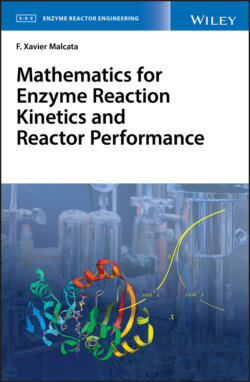Читать книгу Mathematics for Enzyme Reaction Kinetics and Reactor Performance - F. Xavier Malcata - Страница 21
2.1.3 Arithmetic/Geometric Series
ОглавлениеAn arithmetic/geometric sequence is the result of multiplying a geometric progression by an arithmetic progression, and looks like
(2.109)
in general – with k1 serving as increment and k2 serving as ratio, besides u0 serving as first term; one may write Eq. (2.109) in a more condensed form as
(2.110)
– which is a hybrid of Eqs. (2.76) and (2.87). If both sides are multiplied by k2, then Eq. (2.109) becomes
(2.111)
so ordered subtraction of Eq. (2.111) from Eq. (2.109) is in order to yield
(2.112)
– where parentheses were taken out for convenience; after factoring out in the left‐hand side, and condensing similar terms in the right‐hand side, Eq. (2.112) becomes
(2.113)
One may now factor out k1 k2 or (as appropriate) in Eq. (2.113) to obtain
(2.114)
where the content of the first parenthesis in the right‐hand side is but a geometric series containing n terms; insertion of Eq. (2.93) with u0 = 1 unfolds
(2.115)
while division of both sides by 1 − k2 gives then rise to
(2.116)
A graphical representation of Eq. (2.116) is made available in Fig. 2.6 – after recalling Eq. (2.72) and dividing both sides by u0, i.e.
(2.117)
n, k1/u0 and k2 were consequently utilized as independent parameters. An increasing n systematically produces a higher‐value series – and a similar effect is triggered by a larger k1 or a larger k2; there is a horizontal asymptote when k2 = 0.5 (besides the trivial case of k2 = 0), in much the same way horizontal asymptotes arose in Fig. 2.5.
Figure 2.6 Variation of value of n‐term arithmetic–geometric series, Sn, normalized by first term, u0, as a function of n – for selected values of increment, k1, normalized also by u0, and ratio, k2, for (a) k1/u0 = 0, (b) k1/u0 = 0.5, (c) k1/u0 = 1, and (d) k1/u0 = 2.
In general, one realizes that
(2.118)
with the aid of Eqs. (2.72), (2.73), and (2.117), or else
(2.119)
after direct application of the theorems on limits. If ∣k2∣ < 1, then Eq. (2.119) degenerates to
(2.120)
– where the first term entails an unknown quantity, while as n → ∞ was used to simplify the second term; after rewriting the second term in numerator of the first term of Eq. (2.119) as
(2.121)
one gets an unknown quantity of the type ∞/∞ – so one may apply l’Hôpital’s rule to get
(2.122)
Equation (2.122) degenerates to
(2.123)
since ∣k2 ∣ < 1; insertion of Eq. (2.123) allows final transformation of Eq. (2.119) to
(2.124)
which describes the vertical intercept of the horizontal asymptotes in Fig. 2.6 for curves with . Therefore, the series is convergent when −1 < k2 < 1 – irrespective of the actual values of u0 and k1, and divergent otherwise; as expected, Eq. (2.124) degenerates to Eq. (2.98) when k1 = 0.
The trivial case, associated with k1 = 0, transforms indeed Eq. (2.116) to
(2.125)
after having u0 factored out – and serves as descriptor of the curves plotted in Fig. 2.6 a; Eq. (2.125) coincides with Eq. (2.93), corresponding to a plain geometric series, as expected from
(2.126)
that in turn stems from Eqs. (2.87) and (2.110) – thus fully justifying coincidence between Figs. 2.5 and 2.6a. Conversely, k2 = 0 converts Eq. (2.116) to
(2.127)
which serves as descriptor of the bottom curves in Fig. 2.6, labeled as k2 = 0. When k2 → 1, Eq. (2.116) becomes
(2.128)
if the theorems on limits are blindly applied. To circumvent the unknown quantities of the 0/0 type, one may independently differentiate, with regard to k2, numerator and denominator of either term in the right‐hand side of Eq. (2.128), according to
(2.129)
where minus signs may be dropped from numerator and denominator, factored out, and classical theorems on limits considered to reach
(2.130)
upon division of both numerator and denominator of the last term by 1 − k2, one gets
(2.131)
or, equivalently,
(2.132)
once n + 1 has been factored out – which retrieves Eq. (2.83) pertaining to a plain arithmetic series, as expected. This conclusion can also be drawn graphically, by comparing the curves labeled as k2 = 1 in Fig. 2.6 with the lines in Fig. 2.4 corresponding to the same ; and goes along with realization that
(2.133)
based on Eq. (2.110) and matching Eq. (2.76).
